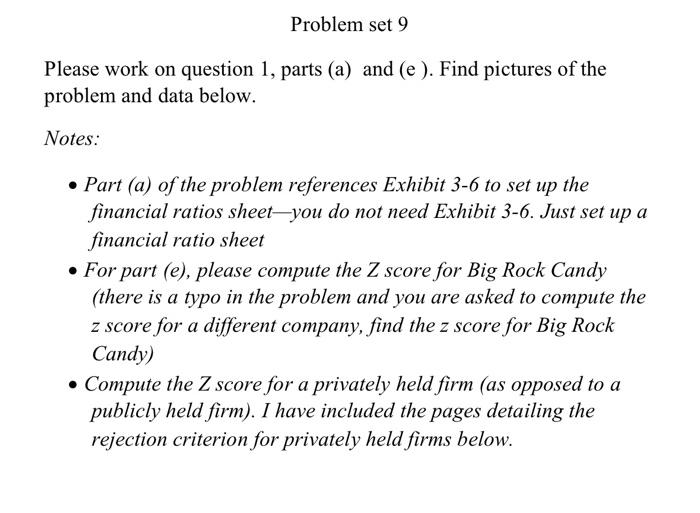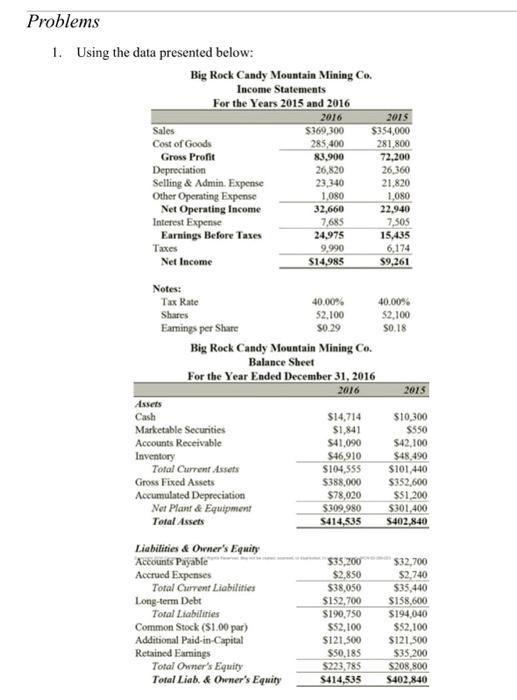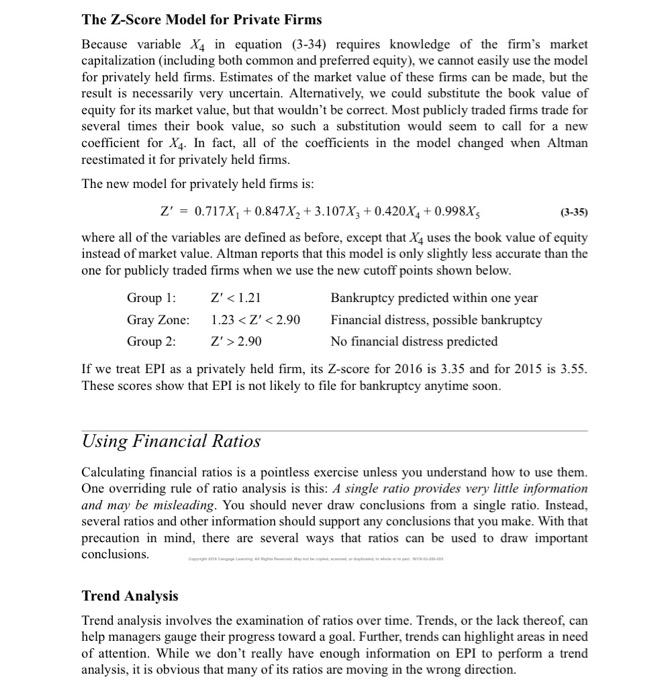Problem set 9 Please work on question 1, parts (a) and (e ). Find pictures of the problem and data below. Notes: - Part (a) of the problem references Exhibit 3-6 to set up the financial ratios sheet-you do not need Exhibit 3-6. Just set up a financial ratio sheet - For part (e), please compute the Z score for Big Rock Candy (there is a typo in the problem and you are asked to compute the z score for a different company, find the z score for Big Rock Candy) - Compute the Z score for a privately held firm (as opposed to a publicly held firm). I have included the pages detailing the rejection criterion for privately held firms below. 1. Copy the Big Rock Candy Mountain Mining financial statements from Problem 1 in Chapter 2 into a new workbook. a. Set up a ratio worksheet similar to the one in Exhibit 3-6, page 92, and calculate all of the ratios for the firm. Using Altman's model for privately held firms, calculate the Z-score for Mike Owjai Manufacturing. Does it appear that the firm is in imminent danger of bankruptcy? 1. Using the data presented below: Big Rock Candy Mountain Mining Co. Income Statements Notes: TaxRateSharesEamingsperShare40.00%52,10050.29 Bigg Rock Candy Mountain Mining Co. Balance Sheet The Z-Score Model for Private Firms Because variable X4 in equation (3-34) requires knowledge of the firm's market capitalization (including both common and preferred equity), we cannot easily use the model for privately held firms. Estimates of the market value of these firms can be made, but the result is necessarily very uncertain. Alternatively, we could substitute the book value of equity for its market value, but that wouldn't be correct. Most publicly traded firms trade for several times their book value, so such a substitution would seem to call for a new coefficient for X4. In fact, all of the coefficients in the model changed when Altman reestimated it for privately held firms. The new model for privately held firms is: Z=0.717X1+0.847X2+3.107X3+0.420X4+0.998X5 where all of the variables are defined as before, except that X4 uses the book value of equity instead of market value. Altman reports that this model is only slightly less accurate than the one for publicly traded firms when we use the new cutoff points shown below. If we treat EPI as a privately held firm, its Z-score for 2016 is 3.35 and for 2015 is 3.55 . These scores show that EPI is not likely to file for bankruptcy anytime soon. Using Financial Ratios Calculating financial ratios is a pointless exercise unless you understand how to use them. One overriding rule of ratio analysis is this: A single ratio provides very little information and may be misleading. You should never draw conclusions from a single ratio. Instead, several ratios and other information should support any conclusions that you make. With that precaution in mind, there are several ways that ratios can be used to draw important conclusions. Trend Analysis Trend analysis involves the examination of ratios over time. Trends, or the lack thereof, can help managers gauge their progress toward a goal. Further, trends can highlight areas in need of attention. While we don't really have enough information on EPI to perform a trend analysis, it is obvious that many of its ratios are moving in the wrong direction. Problem set 9 Please work on question 1, parts (a) and (e ). Find pictures of the problem and data below. Notes: - Part (a) of the problem references Exhibit 3-6 to set up the financial ratios sheet-you do not need Exhibit 3-6. Just set up a financial ratio sheet - For part (e), please compute the Z score for Big Rock Candy (there is a typo in the problem and you are asked to compute the z score for a different company, find the z score for Big Rock Candy) - Compute the Z score for a privately held firm (as opposed to a publicly held firm). I have included the pages detailing the rejection criterion for privately held firms below. 1. Copy the Big Rock Candy Mountain Mining financial statements from Problem 1 in Chapter 2 into a new workbook. a. Set up a ratio worksheet similar to the one in Exhibit 3-6, page 92, and calculate all of the ratios for the firm. Using Altman's model for privately held firms, calculate the Z-score for Mike Owjai Manufacturing. Does it appear that the firm is in imminent danger of bankruptcy? 1. Using the data presented below: Big Rock Candy Mountain Mining Co. Income Statements Notes: TaxRateSharesEamingsperShare40.00%52,10050.29 Bigg Rock Candy Mountain Mining Co. Balance Sheet The Z-Score Model for Private Firms Because variable X4 in equation (3-34) requires knowledge of the firm's market capitalization (including both common and preferred equity), we cannot easily use the model for privately held firms. Estimates of the market value of these firms can be made, but the result is necessarily very uncertain. Alternatively, we could substitute the book value of equity for its market value, but that wouldn't be correct. Most publicly traded firms trade for several times their book value, so such a substitution would seem to call for a new coefficient for X4. In fact, all of the coefficients in the model changed when Altman reestimated it for privately held firms. The new model for privately held firms is: Z=0.717X1+0.847X2+3.107X3+0.420X4+0.998X5 where all of the variables are defined as before, except that X4 uses the book value of equity instead of market value. Altman reports that this model is only slightly less accurate than the one for publicly traded firms when we use the new cutoff points shown below. If we treat EPI as a privately held firm, its Z-score for 2016 is 3.35 and for 2015 is 3.55 . These scores show that EPI is not likely to file for bankruptcy anytime soon. Using Financial Ratios Calculating financial ratios is a pointless exercise unless you understand how to use them. One overriding rule of ratio analysis is this: A single ratio provides very little information and may be misleading. You should never draw conclusions from a single ratio. Instead, several ratios and other information should support any conclusions that you make. With that precaution in mind, there are several ways that ratios can be used to draw important conclusions. Trend Analysis Trend analysis involves the examination of ratios over time. Trends, or the lack thereof, can help managers gauge their progress toward a goal. Further, trends can highlight areas in need of attention. While we don't really have enough information on EPI to perform a trend analysis, it is obvious that many of its ratios are moving in the wrong direction











